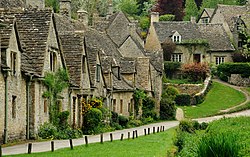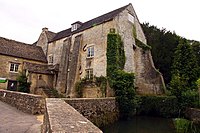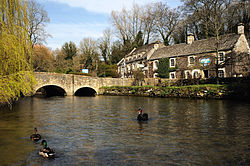Bibury
| Bibury | |
| Gloucestershire | |
|---|---|
 Arlington Row, Bilbury | |
| Location | |
| Grid reference: | SP115066 |
| Location: | 51°45’30"N, 1°49’57"W |
| Data | |
| Population: | 627 (2011) |
| Post town: | Cirencester |
| Postcode: | GL7 |
| Local Government | |
| Council: | Cotswold |
| Parliamentary constituency: |
The Cotswolds |
| Website: | http://www.bibury.com |
Bibury is a village of renowned beauty nestled amongst the Cotswolds in Gloucestershire. It sits on the River Coln, straddling both banks, high above that river’s descent to the Thames.
The village is centred six and a half miles north-east of Cirencester. Bibury village proper, on the east bank of the Coln, consists of approximately forty homes and businesses, of which two are prominent hotels. On the east side of the river is Arlington.
A street in the village, Arlington Row, is an architectural conservation so well regarded for its prettiness that it is depicted on the inside cover of all United Kingdom passports. The village is a major destination for tourists visiting the Cotswolds to soak up its villages, tea houses and many historic buildings. Bilbury is one of six places in Britain featured in the ‘Mini-Europe’ attraction in Brussels.
Parish church

The parish church, St Mary, is very late Anglo-Saxon church with later additions and it is today a Grade I listed building.
The church is for the most part built of cobblestone and coursed rubble limestone with a slate roof. It is formed of a nave with north and south aisles, south porch, north west tower and chancel, tower, arched doorways.[1][2] There is an early canonical sundial on the south wall.
From AD 1130 until the sixteenth century Reformation, the church was a peculiar of Osney Abbey.[2]
On the Arlington (west) side of the village is Arlington Baptist Church, where a congregation has been meeting since the 1740s.[3]
History
In the Domesday Book of 1086 the place is named Becheberie, and it is recorded that the lands and church in Bibury were held by St Mary's Priory at Worcester. In 1130 the manor passed to the Abbey of Osney, near Oxford, which held the manor until the Dissolution of the Monasteries in 1540.[4]
Adjacent to the church is the village primary school that was built in the 1850s.
Late in the nineteenth century George Witts recounted the discovery of the Bibury Roman villa: "In the year 1880 a Roman villa was accidentally discovered in the parish of Bibury, about six miles northeast of Cirencester. Some Roman pottery, coins, remnants of tesselated pavements, &c., were found, but as no examination has yet taken place, no description of the building can be given."—George Witts, 1883[5] The site fills a small low meander downstream of the bridge on the Arlington, Bibury side.[6]
Sights of the village

William Morris, the founder of the nineteenth-century Arts and Crafts movement, visited Bibury and called it "the most beautiful village in England".[7][8]
The village is known for its honey-coloured seventeenth century stone cottages with steeply pitched roofs, which once housed weavers who supplied cloth for fulling at nearby Arlington Mill. Until the 1980s, that building also housed the museum of Arlington Mill with a collection of period clothing, before it was shifted to Barnsley House.[8] The Mill is now a private residence.[9]
 |
 |
The place where the wool was hung to dry after being washed in Arlington Row, was known as "Rack Isle". Today, this water meadow and marshy area, which is seasonally flooded and surrounded by water from three sides, is an important habitat for water-loving plants and birds including mallards, coots, and moorhens; it is also a National Trust Wildfowl Reserve.[10][11]
Bibury is particularly frequented by Japanese tourists. This is largely attributed to the Emperor Showa (Hirohito) who stayed in the village on his European tour.[12][13][14]
The largest building in Bibury is Bibury Court, built in 1633 in the style of Jacobean architecture.[15] It is a Grade I listed building, and was recently a hotel. The hotel has now closed permanently with its future unknown. Previously the house was the home of Lord Sherborne but in 2008 it was bought by John Lister, of Shipton Mill organic flour.[16]
The village has a tennis court downstream of where the main road turns away to the north-west, close to the church and Bibury Court. Ablington Manor, on Potlicker's Lane, was built in 1590, and is also a Grade I listed building.
Arlington Row
The picturesque Arlington Row cottages were built in 1380 as a monastic wool store. This was converted into a row of cottages for weavers in the seventeenth century.[10] The cloth produced there was sent to Arlington Mill.
Arlington Row is a popular visitor attraction,[8] probably one of the most photographed Cotswold scenes, and was preserved by the Royal College of Arts. It has been used as a film and television location, most notably for the films Stardust and Bridget Jones's Diary.[13][17][18][19]
In 2017 the BBC reported that an "ugly" car parked here by an elderly motorist had been vandalised, possibly by visitors who had repeatedly claimed complained that it spoilt photographs.[20]
Geography

The Coln, a tributary of the Thames, flows in a valley in the Cotswolds that is very steep by the standards of the Thames Basin in general, heading south-eastwards. It flows alongside the midsection of Bibury forcing Arlington's main street into a dogleg. Each side has a similar concentration and scale and on each side a conservation area has been declared to preserve its charm.
The parish is approximately rectangular and stretches far to the rolling, elevated, north, to take in an outlying settlement, Ablington in the upper valley. Akeman Street, a Roman road, runs along the south of the parish.
The Coln, along with the Bibury Spring, supplies Bibury Trout farm, founded in 1902 by the naturalist Arthur Severn, to stock the local rivers and streams with the native Brown Trout. The hatchery spawns up to six million trout ova every year.[21]
Three mediæval clusters are all interspersed by substantial grass making for a dense developed area compared to suburbs but not in terms of roads; a footbridge connects both sides (Arlington and Bibury) as well as various footpaths in all directions. Elevations vary widely even throughout the village parts, with the gentlest slope in the eastern escarpment of the Cotswold Hills for a mile or more in each direction taken by the main village road.
Sport
The world's first horse racing club, The Bibury Club, was formed in 1681 and held race meetings on Macaroni Downs above the village until the early part of the twentieth century.[22]
Outside links
| ("Wikimedia Commons" has material about Bibury) |
- Pictures of Bibury and the area on Geograph.co.uk
- BBC archive film of Bibury from 1986
- Bibury Baptist Church
- Bibury Primary School
References
- ↑ National Heritage List 1155770: Bibury Church
- ↑ 2.0 2.1 Nikolaus Pevsner: Pevsner Architectural Guides
- ↑ Arlington Baptist Church
- ↑ Croome, W I: 'A Short History of St Mary's Bibury' (The British Printing Company Ltd, 1992)
- ↑ Witts, George: 'Archaeological Handbook of the County of Gloucester' (G. Norman, 1883)
- ↑ National Heritage List 1003357: Site of Roman Villa near Bibury Mill
- ↑ A History of the County of Gloucester - Volume 7 pp 21-24: {{{2}}} (Victoria County History)
- ↑ 8.0 8.1 8.2 "Gloucestershire - History - Day Out: The South East Cotswolds". BBC. Jan 2009. http://www.bbc.co.uk/gloucestershire/content/articles/2008/10/23/dayout_se_cotswolds_video_feature.shtml. Retrieved 7 August 2013.
- ↑ Top 15 unusual buildings for sale: 02: Daily Telegraph
- ↑ 10.0 10.1 "Bibury". National Trust. http://www.nationaltrust.org.uk/bibury/. Retrieved 7 August 2013.
- ↑ "Domesday Reloaded: Wildlife On Rack Isle, Bibury". BBC. http://www.bbc.co.uk/history/domesday/dblock/GB-408000-204000/page/5. Retrieved 7 August 2013.
- ↑ Dalton, Nick (2012). Frommer's England and the Best of Wales. Wiley. https://books.google.co.uk/books?id=NtkCnODXfH8C&pg=PT637&lpg=PT637&dq=emperor+hirohito+bibury&source=bl&ots=dK-72iYXyu&sig=eML_UY-Hp0q-3kSI-lAPotwFMeE&hl=en&sa=X&ei=O2LfU_SLJ-mw7Abt-YDwAQ&ved=0CDMQ6AEwAw#v=onepage&q=emperor%20hirohito%20bibury&f=false.
- ↑ 13.0 13.1 http://www.gloucestershireecho.co.uk/Passport-picture-influx-tourists-according-Bibury/story-21747410-detail/story.html
- ↑ http://biburyshop.blogspot.co.uk/2010/05/japanese-and-english.html
- ↑ Bibury Court Hotel, Cotswolds, Gloucestershire: review, Fiona Duncan in The Telegraph
- ↑ Hotel review: Bibury Court, near Cirencester, Gloucestershire, Daily Mail 16 December 2011
- ↑ @IMDB Website
- ↑ Quiet Gloucestershire village an unlikely tourist attraction: The Daily Mail
- ↑ 'Beauty spots appear on new passports': Gloucester Citizen
- ↑ 'Notorious yellow car vandalised in Bibury', BBC News, 4 February 2017
- ↑ Bibury Trout Farm
- ↑ "The CotsWolds:Horse Racing". Thecotswoldgateway.co.uk. http://thecotswoldgateway.co.uk/horseracing.htm. Retrieved 7 August 2013.
- Ray Lipscombe: 'Bibury Seasons' (Memoirs Publishing, 2011) ISBN 978-0-9565102-1-1
